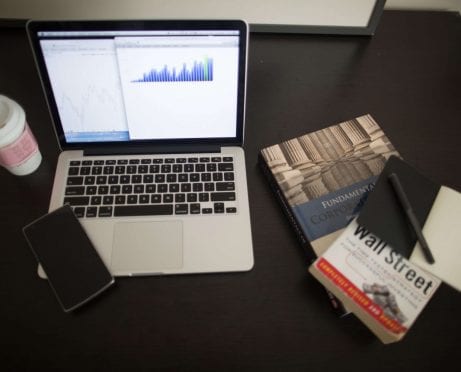
So you know investing can help you grow your wealth over time, but you have no clue where to start. Don’t worry, you’re not alone. Investing can seem complex and confusing. However, if you boil it down to the basics it isn’t as bad as you’d think. Here’s what you need to know to start investing.
Types of Investments
There are a wide variety of investments you can choose, but the most commonly known are stocks, bonds, mutual funds, and exchange-traded funds (ETFs).
- Stocks are pieces of ownership in individual companies.
- Bonds are essentially debt that another party, such as a company or government, has promised to repay you.
- Mutual funds are a combination of investments that allow you to diversify by buying a group of investments without buying each individual underlying investment, such as stocks and bonds, individually.
- An exchange-traded fund is like a mutual fund except they trade throughout the day rather than just once per day and have other features that may make them more attractive to certain investors.
Investing Costs
Whenever you invest, there is almost always a cost to invest. You may have to pay a fee to buy or sell a particular investment. Some investments charge management fees throughout the years.
If you invest through a financial adviser, you may have to pay the adviser a percentage of the assets they manage or a commission, such as a percentage of each purchase or sale of an investment you make.
Before you start investing, make sure you understand all of the fees you’ll be charged.
You should try to keep these fees as low as possible in most cases, as they eat away at any investment returns.
Minimum Requirements to Start Investing
Depending on what you decide to invest in and how you decide to invest, there may be a minimum amount required to start investing. For example, some mutual funds have minimum initial investments of $100, $1,000, $3,000, $10,000, or more.
To buy individual stocks, you usually need enough money to purchase a single share of a company plus any trade fees. To start investing in individual bonds, most brokers require a minimum of $1,000 to $5,000. And to purchase an ETF, you’ll need enough to buy a single share of the ETF, plus any transaction fees.
Thankfully, there are many investment companies that allow you to get around these minimums. However, you may have to pay fees to make up for the convenience.
Diversification
When you invest, you don’t want to put all of your eggs in one basket.
If you choose only one company or one bond to invest in and the investment you choose turns out to be a dud, you could lose everything.
Instead, the concept of diversification can help you spread out the risk of investing.
Essentially, diversification means you invest in several companies or bonds to spread out the risk. One investment may end up being a complete loser and end with a value of zero, but one of your other investments may turn out to be a home run and give you returns of 100 percent or more. By being diversified, your winners will help offset your losers, and hopefully you’ll receive a solid positive return over time.
Risk Tolerance
Another important investing concept is risk tolerance. This concept focuses on managing your investments based on how much risk you can handle before you freak out and make an irrational investing decision as well as the timeline to reach your goals.
The less risk you can handle, the more conservative your investments should be. The more risk you can handle, the more aggressive your investments can be.
More conservative investments will likely have lower returns and require you to invest more money to reach the same goal as someone with a higher risk tolerance that invests in more aggressive investments.
Don’t overestimate your risk tolerance.
If you invest riskier than you can handle, you’ll likely find yourself selling your investments when they’ve decreased significantly in value. This, in turn, could result in massive losses you may not be able to recover from.
“Choose an asset allocation based on your goals and risk tolerance, and don’t try to follow every market whim,” says Brandon Renfro, an assistant professor and financial planner in Hallsville, Texas.
Places to Start Investing
We’ve just touched on the tip of the iceberg when it comes to investing, but you now know some of the most important concepts about the basics of investing. If you’re ready to learn even more and start investing, you have quite a few options to choose from.
If you don’t have a lot of money to invest, you’re usually best off investing with one of the newer fintech companies or apps. Some of these apps have extremely low or no minimum investment requirements.
If you don’t like these options, another alternative is saving up enough money to buy into an investment that has a higher minimum initial investment. Usually, once you cross that threshold, you can make smaller purchases to add more to your account. For instance, VFIFX, Vanguard’s 2050 Target Retirement Date Fund, has a minimum initial investment of $1,000. After that, you can make additional investments as small as just $1.
What to Expect as a New Investor
“Have patience when you first start investing. Everyone likes to talk about the effect of compound returns over the long run. The other side of that coin is that things go slowly at first. Stick it out to see the compound growth,” Renfro says. But this isn’t the only thing you should keep in mind as a new investor.
“Keep in mind that the market goes in cycles,” Renfro adds.
“If you are just starting out, then you’ll have limited experience. You’ll be tempted to imagine the future of the market based on that experience, whether it is good or bad. Either way, use caution and don’t expect returns to just repeat themselves. Good returns or bad won’t persist forever. Just know that the market will fluctuate, and you’ll see the other side.”
The key is remembering that you’re investing for the long haul. The short term swings won’t matter as much as long as you stick to your investing plan. Then, decades from now, you’ll hopefully be wealthier than you are today. But you have to get started to gain the benefit of investing. Find a way to start investing today. You’ll be glad you did.











